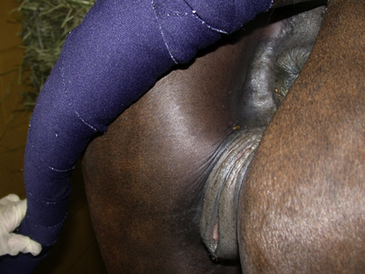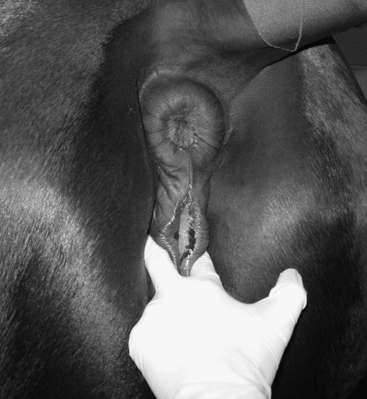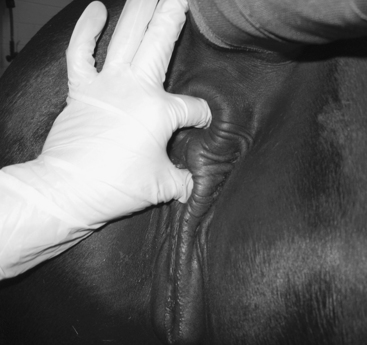CHAPTER 168 Conditions of the External Genitalia of Mares
EXAMINATION OF THE PERINEUM
Perineal conformation is one of the most important influences on a mare’s fertility. Poor perineal conformation increases the risk of developing pneumovagina, urovagina, and uterine fluid accumulation, all of which can substantially impair fertility. With increasing age, number of foals produced, and particularly following foaling trauma, the integrity of the barriers protecting the mare’s uterus from external contamination becomes compromised.
Evaluation of the mare should include thorough inspection of the perineum (anus, vulva, and skin under the tail) and buttocks for signs of vulvar discharge, ulcerative lesions, tumors, and perineal conformation. Overall pelvic conformation is an important consideration because many mares with reproductive problems have a flat croup with a high tailhead and downward slope to the pelvis. A sunken anus is associated with shelf formation of the dorsal aspect of the vulva, leading to fecal contamination of the vagina (Figure 168-1). Mares with poor body condition or fillies that are in fit racing condition and lacking perineal fat often have poor perineal conformation and are predisposed to developing pneumovagina.
Three important barriers protect the reproductive tract of the mare from external contamination: the vulvar seal, vestibulovaginal sphincter, and cervix. Functional defects in any of these barriers have the potential to impair fertility. Each of these barriers should be assessed for proper form and function. The vulvar seal is formed by a combination of factors. The labia should be full and firm and should lie in apposition to one another. Normal integrity of the constrictor vulvae muscles prevents inrushing of air into the vagina when the vulvar labia are parted. The dorsal commissure of the vulva should be less than 4 cm above the pelvic floor at the level of the ischial tuberosities (Figure 168-2) such that less than one third of the vulvar length lies above the level of the pelvic floor and at least two thirds of the length lies below. The vulvar labia should be on a vertical or near-vertical plane. Deviation of more than 10 degrees beyond vertical is associated with reduction in fertility.
CASLICK’S INDEX
An additional consideration is the integrity of the perineal body, which here is defined as the area of tissue lying between the rectum and vagina. Defects of the perineal body can be the result of multiple foalings or traumatic injury during foaling. The perineal body is assessed by placing a gloved first finger into the rectum and the thumb just inside the dorsal aspect of the vulva (Figure 168-3). In mares with normal conformation, there should be at least 3 to 4 cm of firm tissue in the perineal body.
CASLICK SUTURE
Stay updated, free articles. Join our Telegram channel

Full access? Get Clinical Tree





